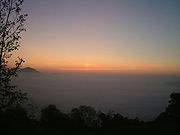
False sunrise
Encyclopedia

Halo (optical phenomenon)
A halo from Greek ἅλως; also known as a nimbus, icebow or gloriole) is an optical phenomenon produced by ice crystals creating colored or white arcs and spots in the sky. Many are near the sun or moon but others are elsewhere and even in the opposite part of the sky...
.
It is an atmospheric optical phenomenon associated with the reflection or refraction of sunlight by small ice crystals making up cirrus
Cirrus cloud
Cirrus clouds are atmospheric clouds generally characterized by thin, wispy strands, giving them their name from the Latin word cirrus meaning a ringlet or curling lock of hair...
or cirrostratus cloud
Cirrostratus cloud
Cirrostratus clouds are thin, generally uniform clouds, composed of ice-crystals. They are difficult to detect and if capable of forming halos the cloud takes the form of thin cirrostratus nebulosus. The cloud has a fibrous texture with no haloes if it is thicker cirrostratus fibratus. On the...
s in the very particular case when the sun is still below the horizon.
The spread light of a false sunrise has less power than that of a real sun, but sometimes is amazingly similar in its visual behaviour at distance. It is very similar to a subsun
Subsun
A subsun or sub-sun is a glowing spot seen within clouds when the clouds are observed from above. The subsun appears directly below the sun, as if it were caused by sunlight reflecting from a body of water. The reflection is caused by large numbers of flat ice crystals...
, except that in a false sunrise the sun is below the horizon and the ice crystals are above it.
See also
- False sunsetFalse sunsetA false sunset or sunset sundog is a very particular kind of parhelion, belonging to the optical phenomenon family of halos.It is an atmospheric optical phenomenon associated with the reflection and refraction of sunlight by small ice crystals making up cirrus or cirrostratus clouds in the very...
- Belt of VenusBelt of VenusThe Belt of Venus or Venus's Girdle is the Victorian-era name for an atmospheric phenomenon seen at sunrise and sunset. Shortly after sunset or shortly before sunrise, the observer is, or is very nearly, surrounded by a pinkish glow or antitwilight arch that extends roughly 10°–20° above the horizon...
- Crepuscular raysCrepuscular raysCrepuscular rays , in atmospheric optics, are rays of sunlight that appear to radiate from a single point in the sky. These rays, which stream through gaps in clouds or between other objects, are columns of sunlit air separated by darker cloud-shadowed regions...
- GegenscheinGegenscheinThe gegenschein is a faint brightening of the night sky in the region of the antisolar point.- Explanation :Like the zodiacal light, the gegenschein is sunlight reflected by interplanetary dust...
- GloryGlory (optical phenomenon)A glory is an optical phenomenon that resembles an iconic saint's halo about the shadow of the observer's head. The effect is produced by light backscattered towards its source by a cloud of uniformly sized water droplets...
- Milky WayMilky WayThe Milky Way is the galaxy that contains the Solar System. This name derives from its appearance as a dim un-resolved "milky" glowing band arching across the night sky...
- MirageMirageA mirage is a naturally occurring optical phenomenon in which light rays are bent to produce a displaced image of distant objects or the sky. The word comes to English via the French mirage, from the Latin mirare, meaning "to look at, to wonder at"...
- Noctilucent cloudNoctilucent cloudNight clouds or Noctilucent clouds are tenuous cloud-like phenomena that are the "ragged-edge" of a much brighter and pervasive polar cloud layer called polar mesospheric clouds in the upper atmosphere, visible in a deep twilight. They are made of crystals of water ice. The name means roughly night...
- Parhelic circleParhelic circleA parhelic circle is a halo, an optical phenomenon appearing as a horizontal white line on the same altitude as the sun, or occasionally the Moon. If complete, it stretches all around the sky, but more commonly it only appears in sections....
- SkyglowSkyglowSkyglow is the illumination of the night sky or parts of it. The most common cause of skyglow is artificial light that emits light pollution, which accumulates into a vast glow that can be seen from miles away and from high in the sky...
- Subparhelic circleSubparhelic circleThe subparhelic circle is a rare halo, an optical phenomenon located below the horizon. It passes through both the subsun, below the sun, and the antisolar point, opposite to the sun...
- Sun pillar
- Zodiacal lightZodiacal lightZodiacal light is a faint, roughly triangular, whitish glow seen in the night sky which appears to extend up from the vicinity of the sun along the ecliptic or zodiac. Caused by sunlight scattered by space dust in the zodiacal cloud, it is so faint that either moonlight or light pollution renders...

